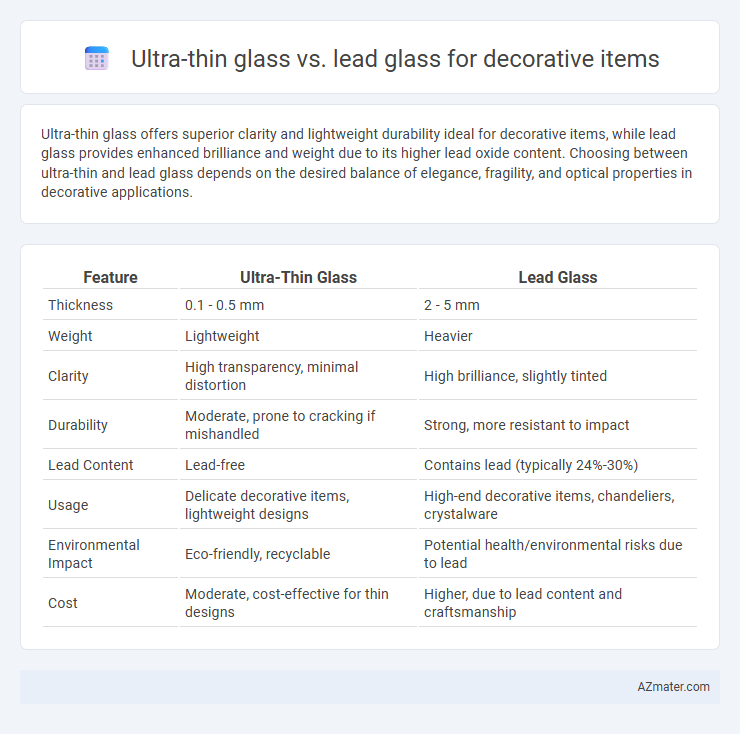Ultra-thin glass offers superior clarity and lightweight durability ideal for decorative items, while lead glass provides enhanced brilliance and weight due to its higher lead oxide content. Choosing between ultra-thin and lead glass depends on the desired balance of elegance, fragility, and optical properties in decorative applications.
Table of Comparison
| Feature | Ultra-Thin Glass | Lead Glass |
|---|---|---|
| Thickness | 0.1 - 0.5 mm | 2 - 5 mm |
| Weight | Lightweight | Heavier |
| Clarity | High transparency, minimal distortion | High brilliance, slightly tinted |
| Durability | Moderate, prone to cracking if mishandled | Strong, more resistant to impact |
| Lead Content | Lead-free | Contains lead (typically 24%-30%) |
| Usage | Delicate decorative items, lightweight designs | High-end decorative items, chandeliers, crystalware |
| Environmental Impact | Eco-friendly, recyclable | Potential health/environmental risks due to lead |
| Cost | Moderate, cost-effective for thin designs | Higher, due to lead content and craftsmanship |
Introduction to Ultra-thin Glass and Lead Glass
Ultra-thin glass offers exceptional clarity and lightweight properties, making it ideal for delicate decorative items that require precision and elegance. Lead glass, known for its high refractive index and brilliance due to lead oxide content, provides a sparkling finish that enhances ornate designs. Comparing both materials highlights ultra-thin glass's modern minimalism against lead glass's classic luminous appeal in decorative applications.
Material Composition: Ultra-thin Glass vs Lead Glass
Ultra-thin glass is composed primarily of silica with minimal additives, resulting in a lightweight, highly transparent, and flexible material suitable for modern decorative items. Lead glass contains a significant proportion of lead oxide, typically between 18% and 40%, which increases its density, refractive index, and brilliance, making it ideal for traditional, high-luster decorations. The absence of lead in ultra-thin glass offers a non-toxic, environmentally friendly alternative with enhanced durability and versatility compared to the heavier, more fragile lead glass.
Aesthetic Appeal and Design Flexibility
Ultra-thin glass offers a sleek, modern aesthetic with exceptional clarity and a lightweight profile, making it ideal for intricate, minimalist decorative items that emphasize elegance and transparency. Lead glass, known for its high refractive index and brilliance, delivers a classic, luxurious sparkle, enhancing decorative pieces with rich, vibrant light refraction and detailed craftsmanship. Design flexibility favors ultra-thin glass for innovative, dynamic shapes and layering techniques, while lead glass excels in traditional, precise cuts and ornate embellishments that highlight its optical properties.
Durability and Strength Comparison
Ultra-thin glass offers excellent durability due to its flexibility and resistance to shattering, making it ideal for delicate decorative items. Lead glass, known for its high density and weight, provides superior strength and impact resistance, enhancing the longevity of decorative pieces. While ultra-thin glass excels in lightweight applications, lead glass is preferred for decorations requiring robust, heavy-duty durability.
Transparency and Optical Clarity
Ultra-thin glass boasts superior transparency and optical clarity due to its minimal thickness and advanced manufacturing processes, making it ideal for decorative items requiring a sleek, modern look. Lead glass, while prized for its brilliance and high refractive index, often exhibits slight cloudiness that can diminish clarity in intricate designs. The reduced distortion and enhanced light transmission of ultra-thin glass provide a clearer, more vibrant appearance compared to traditional lead glass in decorative applications.
Weight Advantages for Decorative Items
Ultra-thin glass offers significant weight advantages over lead glass, making it ideal for decorative items requiring ease of handling and installation. With a thickness often less than 1 mm, ultra-thin glass reduces overall product weight by up to 50% compared to traditional lead glass, facilitating safer and more versatile design applications. This lightweight property allows for intricate designs without compromising structural integrity, enhancing both aesthetic appeal and functionality in decorative pieces.
Environmental Impact and Safety Concerns
Ultra-thin glass offers significant environmental advantages over lead glass by reducing raw material use and energy consumption during production, resulting in a smaller carbon footprint. Lead glass poses substantial safety concerns due to its toxic lead content, which can leach harmful substances into the environment and pose health risks during manufacturing and disposal. Choosing ultra-thin glass for decorative items fosters safer handling and sustainability, minimizing both ecological damage and exposure to hazardous materials.
Cost Considerations for Decorative Applications
Ultra-thin glass offers a higher upfront cost due to advanced manufacturing processes, but its lightweight nature reduces shipping and handling expenses in decorative applications. Lead glass, while typically less expensive initially, incurs additional costs over time related to its heavier weight and environmental disposal requirements. Evaluating total cost of ownership, including fabrication, transportation, and sustainability factors, is crucial when choosing between ultra-thin glass and lead glass for decorative items.
Popular Uses in Modern Décor
Ultra-thin glass is popular in modern decor for minimalist designs, sleek furniture, and light fixtures due to its lightweight and durability. Lead glass, known for its high refractive index and brilliance, remains favored in decorative items like chandeliers, luxury vases, and ornamental bowls that require enhanced sparkle. Both materials offer unique aesthetic qualities, with ultra-thin glass emphasizing transparency and subtlety, while lead glass highlights elegance and visual impact.
Choosing the Best Glass Type for Your Decorative Needs
Ultra-thin glass offers exceptional clarity and modern elegance, making it ideal for minimalist and sleek decorative items, while lead glass provides brilliant brilliance and weight, enhancing traditional luxury pieces. Consider ultra-thin glass for lightweight, contemporary designs requiring durability and ease of handling, whereas lead glass is preferred for its high refractive index and classic aesthetic in ornamental items. Selecting the best glass depends on balancing aesthetic goals, durability needs, and the visual impact desired for your decorative project.

Infographic: Ultra-thin glass vs Lead glass for Decorative item
 azmater.com
azmater.com